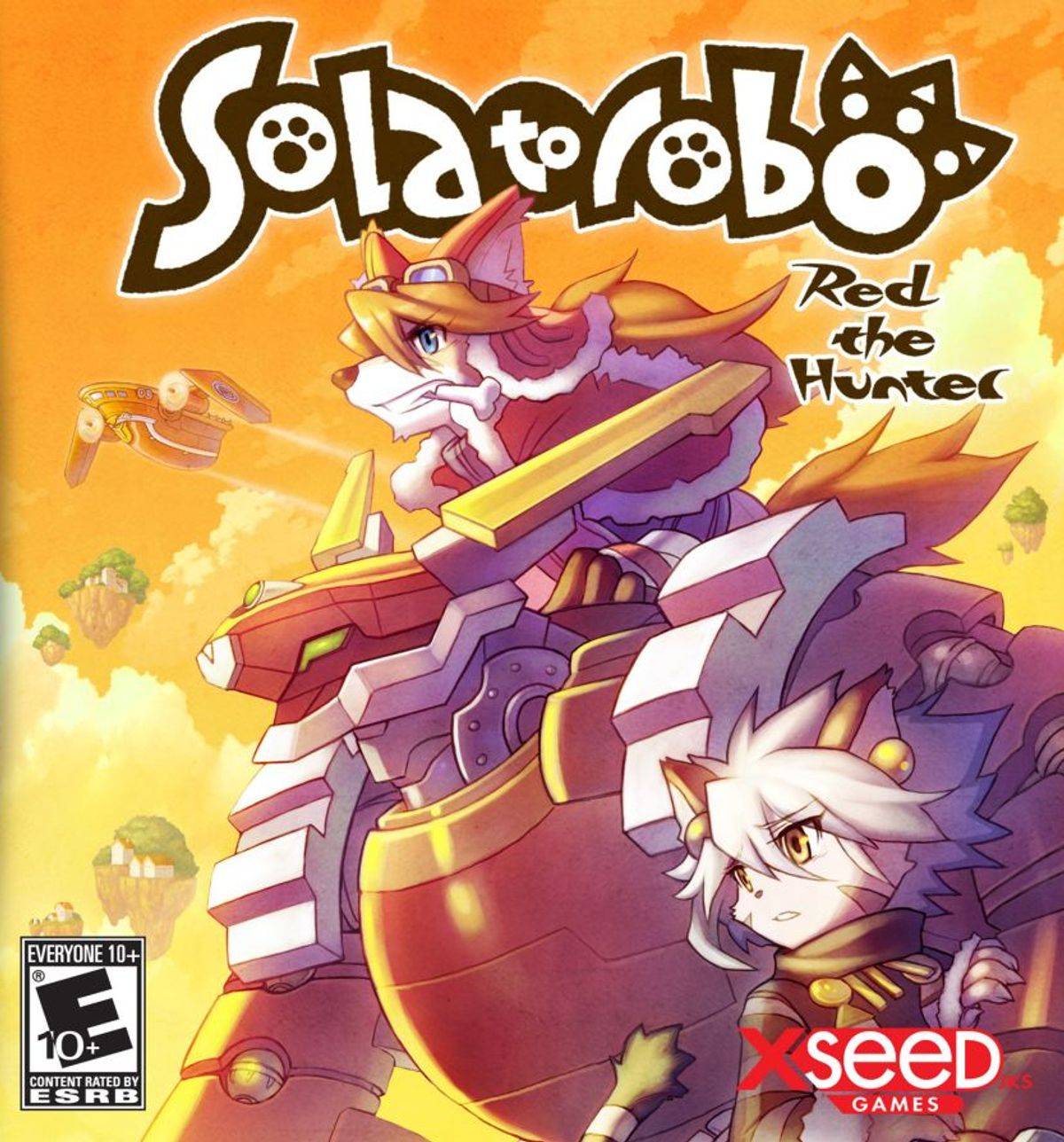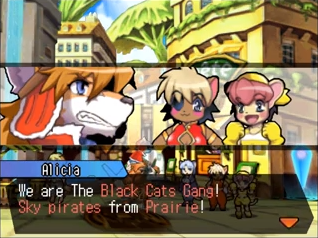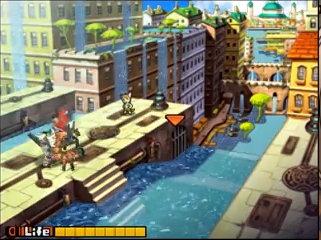Date of upload: October 12, 2025
Hello and welcome to this website's inaugural review…ramble…thing. I might rename this section of the website at a later point depending on how I feel, who knows. Anyways, this section of the website serves to document my feelings on specific pieces of media I've consumed recently.
If, by chance, you happen to stumble upon this, or any of these review-type things in the future, I hope my words encourage you to check out whatever it is I'm talking about. I relish the opportunity to talk about anything that might interest me on here, without the risk of scrutiny that comes with posting to something like Twitter.
But enough preamble! Today's ramble concerns the obscure Nintendo DS action RPG, Solatorobo: Red the Hunter.
Do you ever just experience a piece of media and think, “Damn, this would've changed my life if I had experienced it while I was a child.” Just, imagining what life would have been like if circumstances were juuuuuust different enough that you could have played or watched something back when it was new?
I remember having this exact feeling with Mega Man Legends last year, and much unlike that game this one is for a system I actually owned growing up, so I could have, in theory, played this while it was still new. A fairly unlikely hypothetical, given that this game was primarily advertised through gaming magazines over here in the west, and this game came out just as gaming-related print media was starting to die out, so it’s entirely possible that I still would have missed out on this game regardless.
Thankfully, all is not lost, and I did find this game eventually. After having played this game’s prequel FUGA: Melodies of Steel, I eventually became aware of Solatorobo through The RPG Monger’s video on the game. I…then proceeded to wait a good two years after watching that video to play the game myself, due to a combination of my extensive backlog and getting over my aversion to playing games through…less-than-official means, shall we say. Look, being a Nintendo fan growing up kinda did some things to my brain, okay?
And, unfortunately, said less-than-official means are pretty much your only way of playing this game in the modern day, given that this game in particular is partially owned by Bandai Namco and thus the game’s developer, CyberConnect2, would more than likely have to work things out with them if they ever wanted to rerelease this game. If you want to actually financially support the people who made the game, pick up the FUGA: Melodies of Steel trilogy on your gaming platform of choice. Also you should play those games in general, because they are very good turn-based RPGs. Well, the first one is, I can’t vouch for the second or third ones as I haven’t played them yet. I am getting sidetracked, I apologize.

But what actually happens in this game? Solatorobo puts you in the shoes of an upbeat, energetic dog person named Red Savarin. Red, alongside his sister Chocolat, travels across the floating islands of the France-inspired Shepherd Republic doing various freelance jobs as a “hunter.” While on a mission to raid an airship, Red stumbles upon a strange medallion, the activation of which summons a giant monster named Lares, who then proceeds to shoot down the airship Red was sent to raid. While in the process of escaping, Red stumbles upon a mysterious youth named Elh, who will end up having a major impact on Red’s life over the course of the story.
From here, the story settles down a bit, and the gameplay loop begins to establish itself. A sizable chunk of Solatorobo’s gameplay revolves around doing quests. Most of them are optional, but there are a small handful that are necessary for story progression. Thankfully these don’t fall into the usual trite sidequest trappings of “go to X place to retrieve Y thing,” often requiring you to solve a puzzle, do a minigame, or fight some enemies. It helps that these quests often have a story to go with them, which keeps them consistently engaging throughout. Some of them even involve characters from this game’s spiritual prequel, Tail Concerto, which is a neat bonus for the small handful of people who played that game. I am unfortunately not one of them, I decided to play this game first, but you should probably play that one as well, you’ll probably like that game if you like this one.

Red pilots a robot called the Dahak, the primary function of which is to pick things up. This ability, as you might expect from one of the game’s core mechanics, plays an integral role in both combat and puzzle solving. Solatorobo’s combat is fairly simple, but with enough complexity to it that at no point does it ever feel boring. Combat encounters can be neatly arranged into one of two categories: picking up enemies and repeatedly slamming them into the ground, or picking up projectiles and/or smaller enemies to throw into a much bigger enemy. It is never not satisfying to just slam an enemy into the dirt, then snatch them out of the air for a follow-up. There are also occasional segments where Red has to dismount the Dahak and do something on foot, usually to activate switches. Your only means of defense while not piloting the Dahak is a piddly little stun gun that only immobilizes enemies instead of damaging them. Though, in my experience, the stun gun rarely came up all that often, given that I didn’t usually encounter many enemies in instances where I wasn’t mounted up, and thus I would often forget I even had it in the small handful of situations that actively require it.
There are also a number of customizations that can be made to the Dahak’s parameters, accomplished through the game’s customization screen. There are many parts of various shapes and colors you can acquire throughout the game, each color of part corresponding to one of the Dahak’s four stats. Red Attack parts increase the amount of damage your attacks do, blue Defense parts decrease the amount of damage you take, green Hydraulics parts make it easier to pick things up, and white Mobility parts boost your movement speed. The initial size of your customization screen is quite small, but can be expanded by finding crystals scattered about the overworld. I absolutely adore customization in RPGs, and this scratches that itch perfectly. Systems like this, or the Navi Customizer from the later MegaMan Battle Network games have that feeling of “Okay, how can I make this part fit in here” that greatly satisfies the part of my brain that likes organizing shit.

In addition to the usual questing and story progression, there are minigames you can partake in for rewards like extra cash or parts for the customization screen. The minigames range from things like combat challenges with special rules, to a full-on airplane-racing mode that I am admittedly hot garbage at to what is arguably one of the single hypest fishing minigames in any game ever. Seriously, you fire harpoons at giant hermit crabs so you can salvage things from the battleships they’ve made their homes in, it’s rad as hell.
I now want to take this time to talk about this game’s presentation. As soon as you finish the opening mission, you are treated to an absolutely gorgeous anime opening, courtesy of no less than Studio Madhouse. The game’s graphics in general look damn good for a DS game, featuring a nice mix of 2D characters against 3D backgrounds, which I am always a fan of. On top of that, this game’s small amount of voice acting is done by Japanese voice actors speaking French, which gives this game a completely unique vibe from anything I’ve ever played.

Far and away, though, the story and characters are easily the best part of this game. I won’t go too in depth in this regard, since I want people to experience this game for themselves, but it is a damn good story, and niche games like this with really deep stories are kind of my bread and butter. While it initially starts out as a somewhat rote retelling of the story of Tail Concerto, what with you fighting a Team Rocket-esque trio of bad guys in a race to get a bunch of MacGuffins to seal away the big robot that’s messing everything up, culminating in a showdown with a generic, cartoonishly-evil big bad, gives way to the game’s second half, which really ramps up on the game’s lore and worldbuilding, as well as injecting a healthy dose of tragedy into the whole affair.
And thus ends my ramble/review/whatever about Solatorobo: Red the Hunter. Suffice it to say, I greatly enjoyed my time with this one. The mere act of playing this game gave me immense feelings of nostalgia, despite not having played it until now. This feels like something I would’ve played during middle school while waiting for basketball practice to start. I highly encourage you to check out this game for yourself, if you’re willing to emulate it, or just do what I did and play it on a modded 3DS, because it is indeed surprisingly easy to hack a 3DS. But, if for whatever reason you don’t feel comfortable with doing either of those things and still want to support the people who made the game, pick up the FUGA: Melodies of Steel trilogy on whichever platform you prefer. Just…don’t go looking for a physical copy of Solatorobo, you should never have to pay over $200 USD for a retro game, and your money isn’t even going to the people who made it.
Be sure to let me know what you think about me doing this, and I look forward to doing more of these in the future
Bon courage! ~Nicole